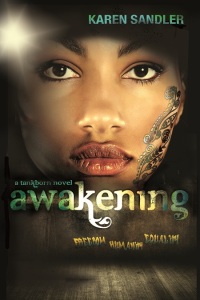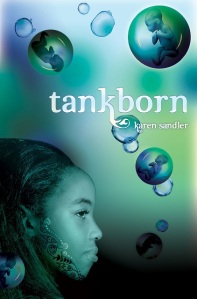 A little over a week ago, I turned in Book 3 of the Tankborn trilogy. A few weeks ago in this blog post, I gave tips on how to finish your novel, suggesting among other things to turn off your internal editor and just soldier through to the end. That there’s plenty of time for revision later.
A little over a week ago, I turned in Book 3 of the Tankborn trilogy. A few weeks ago in this blog post, I gave tips on how to finish your novel, suggesting among other things to turn off your internal editor and just soldier through to the end. That there’s plenty of time for revision later.
Well, once I’d finished Book 3, later became now. I had to switch gears from finish the darn thing to polish the darn thing. I finally had to open the door to that infernal, internal editor who’d been cooling her heels in my mental waiting room. It was time to let her inside to start picking things apart.
In fact, revision is a good time to stuff your ego into that waiting room and let the Evil Blue Pencil Lady rip. Even the most beautiful prose may have to fall to her figurative ax if it has no place in the story.
So what should your inner editor be looking for? Here are ten areas of focus, from simple and mechanical, to more complex developmental issues.
- Fix the typos. That may seem like the most obvious advice ever, but whether you’re planning to indie publish or submit to an editor for traditional publishing, nothing says Amateur more loudly than a typo-riddled manuscript. A reader of indie books might forgive one or two typos (as will an editor at a traditional house), they may never get past the Amazon sample if every other paragraph has a misspelled word or commas where they don’t belong. And if you’re thinking, My word processor will catch my misspellings, Word won’t flag everything, such as an improper use of there, their, or they’re. It takes your own eyeballs to catch that kind of problem.
- Watch for repeated words. Sometimes in the rush of writing your book, you don’t realize you’ve used the word shimmer three times in four paragraphs. Or monstrous. Or fantasy. These are just examples of very distinctive words that need to be used sparingly in a manuscript. You won’t always realize that you’ve overused words like this until you’re doing your revision read-through. You might not even spot them yourself, but your beta reader will. If you find you’ve used monstrous three times in one page (because there’s an enormous beast that must be described), it’s time to pull out the thesaurus. Or go to Reverse Dictionary to find alternate words (such as grotesque, unnatural, and colossal).
- Double check word choice. Are you using effect when you meant to use affect?
 Ravenous when you meant to use rapacious? Sometimes our brains play tricks on us in the heat of writing that first draft and we type a word that’s somewhat similar to another that we meant to type. Or there might be a word you thought meant one thing that actually means another. So make sure you’ve chosen the right word for the right situation.
Ravenous when you meant to use rapacious? Sometimes our brains play tricks on us in the heat of writing that first draft and we type a word that’s somewhat similar to another that we meant to type. Or there might be a word you thought meant one thing that actually means another. So make sure you’ve chosen the right word for the right situation. - Clear out the redundancies. Since Book 3 is part of a trilogy, I felt the need to occasionally catch up the reader on what happened before. As I read through the book I realized I was overdoing it on the catch-up. I didn’t need to mention four times that GENs could be reset and have their personalities wiped away. Once, maybe twice, was enough. Even if your book isn’t part of a trilogy, you might need to remind a reader of a plot point, but be cautious of being repetitious. Delete those redundancies.
- Chuck out your pet weaknesses. What do I mean by pet weaknesses? Just about every writer has a favorite word, type of punctuation, idiomatic expression, or writing device. Sometimes it’s part of their voice, but sometimes it’s just plain habit. For me, it’s the em dash (those long dashes that can break a sentence to insert a separate thought) and its kissing cousin, the ellipse. (…) I allow myself to em dash and ellipse with abandon as I write the draft, then I go back and ruthlessly cut them back. You’ll find a few in the final book, but far fewer than I’d written originally. Make sure you’re not overdoing those pet weaknesses.
- Eliminate the ambiguities. If you get confused at your own prose as you’re reading through (What the heck did I mean by that?), obviously you need to fix and clarify. But sometimes you won’t realize that something in a scene is ambiguous because of all that background you’ve got tucked away in your brain. This is where a beta reader is invaluable, because they won’t have the answers in their head the way you do. They will find the ambiguities. For example, if you wrote, Jenna and LaShonda walked into the room, and she picked up her sword, you’ll know it was LaShonda wielding the sword. But the sentence is ambiguous enough that your beta reader might not figure that out with the sentence written that way. Make sure you’re crystal clear.
- Delete the extraneous. Sometimes when you’re going with the flow writing that first draft, you’ll write a scene that just seems right. Once you’ve finished the book and you’re reading through, you’ll realize that scene never goes anywhere. It doesn’t move the story forward, doesn’t reveal any new important information to the reader, doesn’t add context to the characters or setting. That scene has to go. If there happens to be one little bit of information in it that is useful, you can place that elsewhere. You’re not allowed to leave it in the book just because you like it.
- Pay attention to continuity. Have you ever watched a TV show and in one shot the character’s wine glass is full, then in the next it’s half-full, then it’s full again in the next shot? Someone didn’t pay attention to continuity in that scene. In the case of Book 3 of the Tankborn trilogy, I have a scene early on where the characters have to show their ID to the authorities. Later when my characters encounter the authorities again, I’d forgotten about that entirely. During the revision, I had to put that ID-check into the later scene for continuity’s sake. If you set something up early on in your book, you have to be consistent later.
- Make sure your scenes are in the right order. In general, a book should get more and more exciting from beginning to end. The perils should increase, the revelations should be more and more monumental. You should make sure you have “rising action” from start to finish. If you find that a scene that should be closer to your climax appears too early, switch your scenes around. Don’t be afraid to juggle as needed.
- Answer all story questions. The worst thing you can do is have a reader finish your book and say, “But, but, but…what about that blue horse?” If you had a blue horse on page 134, you’d better “pay off,” i.e., make clear why that blue horse was there, by the end of the book. Never leave the reader hanging, wondering what the heck a particular scene had to do with the story. In fact if there doesn’t seem to be a way to pay a scene off, see number 7 above.
There you go, 10 guidelines for revision. Are there any you think I missed? What do you watch out for during your revision process?

Good advice. A much needed reminder as I’m in revision mode.
A lot of revision I do out of instinct or habit. It was hard putting some of it down in words.
Pingback: Horse of a Different Color and How Writing Matures | karensandler
Pingback: » 10 Must Dos For Manuscript Revision West Lothian Writers